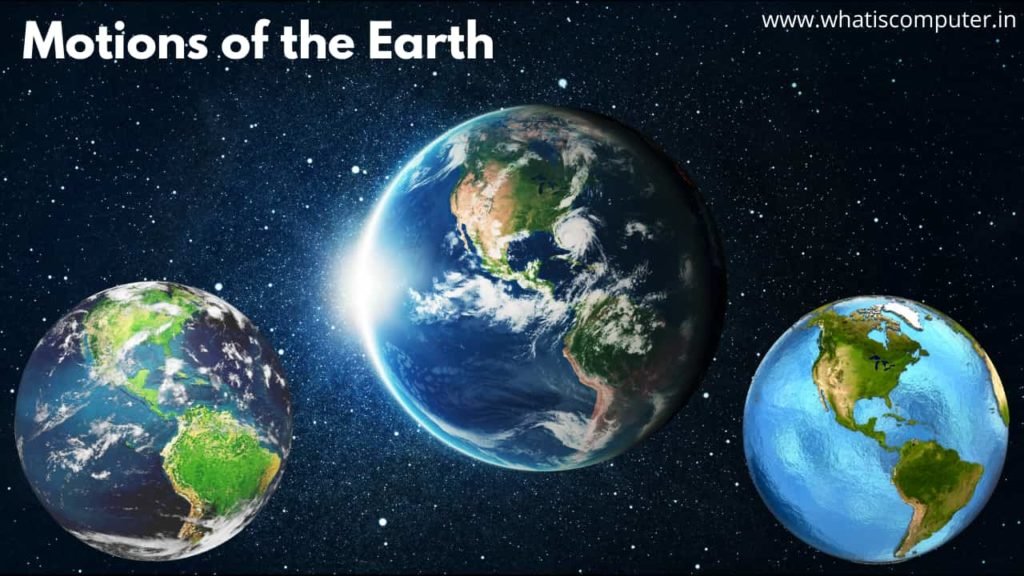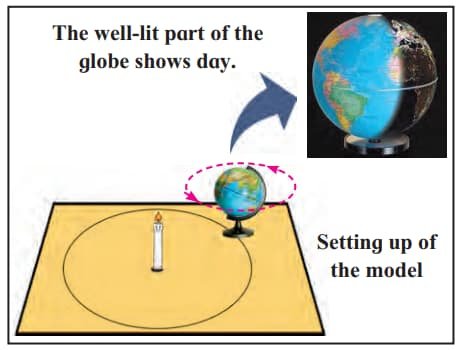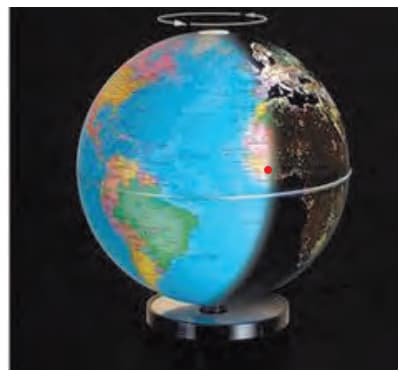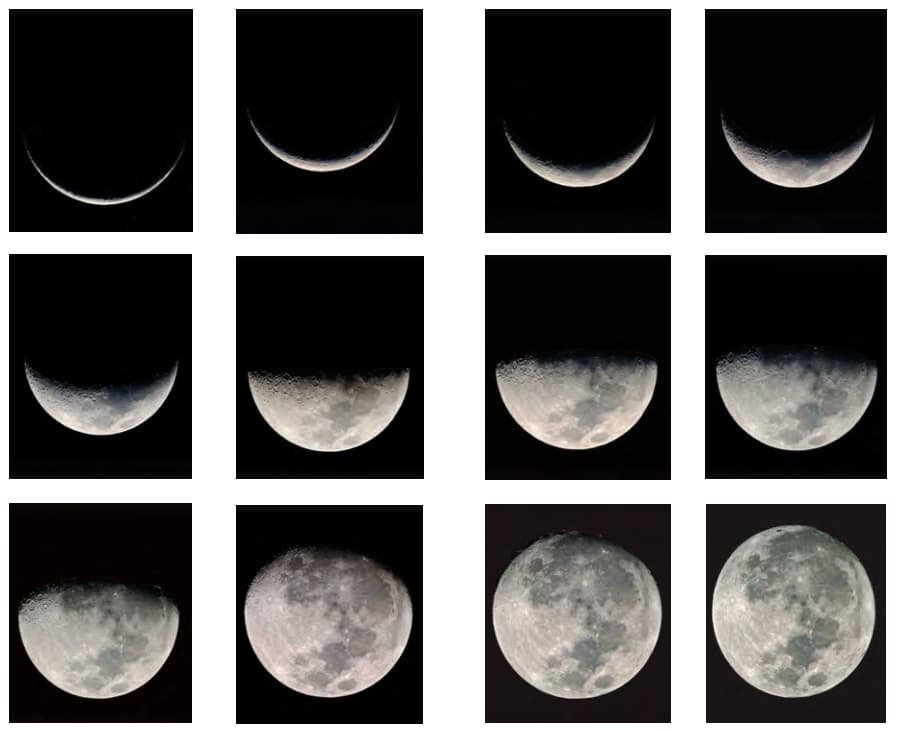Motions of the Earth
Table of Contents

Rotation
Try this.
Take a top. Spin it and observe its movement.
The top turns around itself. Any object that turns about itself actually turns around a certain imaginary line. The turning of an object around itself is called ‘rotation’ and the imaginary line around which it rotates is called the ‘axis of its rotation’.

The Earth’s Rotation
Take a globe like the one in the picture and spin it. Note the line around which it rotates. Now take a plumb-line and hold it close to the globe as shown in the picture. (If you cannot get a plumb-line, tie a long thread to an eraser and make one.)
You will see that the plumb-line and the earth’s axis are at an angle to each other. That is, the earth’s axis is inclined.

The earth rotates with its axis inclined like this. The line NS in the picture shows the earth’s axis. It passes through the centre of the earth. The points N and S are called the poles of the earth. N is the north pole of the earth and S is the south pole.
If a circle were drawn around the surface of the earth exactly in between the north and south poles, it would divide the earth into two equal parts. This imaginary circle is called the ‘equator’. The two equal parts it makes of the earth are called the northern hemisphere and the southern hemisphere respectively.
Try this.
Stand a candle in the middle of a large table. Draw a big circle around the candle. Place a globe at any point on this circle. Light the candle. See that it is dark in the room. Suppose that the candle is the sun.
Observe which part of the globe gets the sun’s light and which one does not.

Now, looking at the globe from the direction of the north pole, turn it anti-clockwise. This is how the earth rotates, i.e. it rotates from west to east. As the earth rotates, its different parts come into the light of the sun one after the other and turn away from it also in the same order.
Sunset and Sunrise
Try this.
Stick a red bindi on the globe. Set up the previous model of the globe and the candle.
Turn the globe anti-clockwise. Note when it is sunrise, noon and sunset at the location of the bindi.

After one sunrise, note when the next one occurs at the bindi. You will see that this happens when the earth completes one rotation, that is, when it makes one complete turn around itself.
This period of time that the earth takes to complete one rotation is called a day. A day has two parts, daytime and nighttime or simply day and night. For the purpose of measuring time, we divide the whole day into 24 parts, each of which is called an hour.
A Year
Try this.
Now, move the globe along the circle on the table. As you do this, keep rotating the globe and ensure that the axis does not change its orientation. Eventually, the globe will come back to its original place on the circle. This is how the earth revolves around the sun even as it rotates around itself. The period of time the earth takes to complete one revolution around the sun is called one year. There are about 365 days and 6 hours in a year.
A leap year
In the Gregorian calendar, the year is taken to have 365 days. It means that it counts 6 hours less every year. That makes 24 hours or one day in every four years. To make up for this lost one day, the month of February in the Gregorian calendar has an extra day every fourth year. That year is called a leap year and it has 366 instead of 365 days and February has 29 instead of 28 days.
Do you know ?
You know that the length of day and night is not always equal. This happens because of the earth’s inclined axis and its revolution around the sun.
In the northern hemisphere, between 22 March and 23 September, the days are longer than the nights. Therefore, it is warmer there. That is, it is summer in the northern hemisphere. However, during this same period in the southern hemisphere, the nights are longer than the days. The earth gets less heat in these parts and therefore it is winter in the southern hemisphere.
In the period from 23 September to 22 March, the days are longer than the nights in the southern hemisphere. It gets more heat and it is summer there.
In this period in the northern hemisphere, it is the nights that are longer. The northern hemisphere gets less heat and it is winter there. Note that there may be differences in these dates due to the leap year. In India, summer, the rainy season and winter are considered to be the main seasons. We also divide the year into six seasons, namely, Vasant, Grishma, Varsha, Sharad, Hemant and Shishir.
This cycle of six seasons is called the ‘rituchakra’. Many of our festivals are connected with the seasons. Many of our songs and games are also related to the different seasons.
Phases of the moon
Can you tell ?
- What is the name given to the changing shapes of the moon that we see ?
- What are the names of the days on which we see a round moon and on which we see no moon at all ?
The full moon and the new moon
The moon revolves around the earth and the earth revolves around the sun. However, these two orbits intersect. Hence, the sun, the moon and the earth are not always along a straight line. We see half of the moon’s surface which faces the earth. That is, from the earth we see only one side of the moon. The moon has no light of its own. We can see the moon because of the sun’s light that falls on it. On a full moon night, we see the entire side of the moon that faces the earth. On a new moon night, we cannot see any of it. From the full moon to the new moon the illuminated part of the moon seen from the earth becomes smaller and smaller. From new moon to full moon it again grows bigger and bigger. These different shapes of the moon that we see are called the phases of the moon.
The lunar month and days (tithi)
You know that it takes 14 or 15 days from new moon to full moon. This is the fortnight of the ‘waxing’ moon. After the full moon, the moon appears smaller and smaller and after 14 – 15 days it is new moon again. This period is the fortnight of the ‘waning’ moon. Thus, the period from one new moon to the next is of 28 – 30 days. It is called the lunar month. Every day of the lunar month is called a tithi.
Always remember the
The rotation of the earth gives rise to day and night. The revolution of the earth and the inclination of its axis give rise to the cycle of seasons.

The new moon The full moon = The waxing moon (Shukla Paksha)
The full moon The new moon = The waning moon (Krishna Paksha)
The fortnight of the waxing moon + The fortnight of the waning moon = A lunar month
What we have learnt
- The rotation of the earth causes day and night.
- The revolution of the earth around the sun and its inclined axis together cause the seasons.
- The revolution of the moon around the earth gives rise to the phases of the moon.
- The period from one new moon to the next is called a lunar month. It has about 28 to 30 days.
- The fortnight ending on a full moon is that of the waxing moon. The fortnight that ends on a new moon is that of the waning moon.
- The days of the lunar month are called ‘tithis’.
Also Read: 9 Ways to Clean Copper Bottles and Utensils at Home